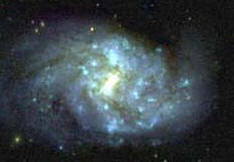
A very blue spiral galaxy from the SDSS
When you look at millions of galaxies as the SDSS does, you can’t classify every one by looking at it and placing it on the Hubble Tuning Fork. If it takes 30 seconds to find and classify a galaxy on the Hubble Tuning Fork, it would take almost 100 years to classify all the galaxies in the SDSS’s Data Release 14! To classify all the galaxies, astronomers need a faster method.
Fortunately, you can use other properties of galaxies to classify them. Astronomers have known for a long time that galaxy type and color are related. Spiral galaxies tend to have more star forming regions, and younger, bluer stars. Elliptical galaxies tend to have mostly old, red stars.
A team of SDSS astronomers looked at the colors, spectra, and visual images of many galaxies to determine how colors are related to galaxy types in SDSS data. The researchers found that galaxies fell into the clearest groups when they looked at the difference between the ultraviolet (u) and red (r) filters. Specifically, the researchers found that most early galaxies (elliptical, SO, and Sa or SBa) had a u-r value greater than 2.22, and that most late galaxies (Sb or SBb, Sc or SBc and Irregular) had a u-r value less than 2.22.
The method of classifying galaxies by their colors is not perfect. There are some unusually red spiral galaxies and some unusually blue elliptical galaxies. However, the method works well enough that it can be used to analyze the properties of large numbers of galaxies fairly easily.
Exercise 4. Look up the following galaxies in the Object Explorer by clicking on their object IDs in the table below. Classify them as early (E, S0, Sa or SBa) or late (Sb or SBa, Sc or SBc, Irr) galaxies from their u-r values (u and r are located to the right of the galaxy’s image). Then, look at their images and classify them on the Hubble tuning fork. (Note: you may need to click on the image and open the Navigate tool to get a better view of the galaxy.)
Use this workbook to keep track of your work.
| Object ID | RA | Dec |
|---|---|---|
1237655560403878129 | 248.920 | 0.331 |
1237662225706123901 | 254.768 | 16.715 |
1237648704068649509 | 248.295 | -0.213 |
1237648704068518498 | 248.051 | -0.304 |
1237655550207197707 | 248.275 | -0.189 |
1237648673997127724 | 248.064 | -0.050 |
1237662306744664864 | 256.022 | 16.764 |
1237668336864788995 | 249.860 | 11.211 |
1237662341631247030 | 256.384 | 17.304 |
1237662635841552623 | 246.455 | 6.336 |
Question 5. How many of the galaxies’ colors match their Hubble Tuning Fork types? How many do not?
Question 6. Do you think color classification is a good (even if it is not perfect) way of classifying galaxies? Why or why not?
